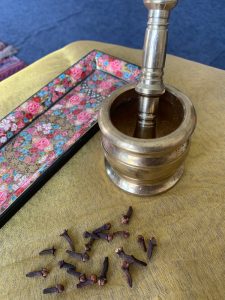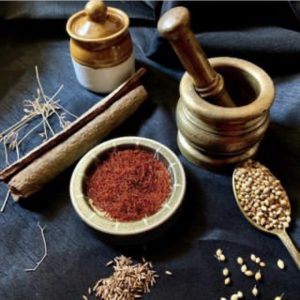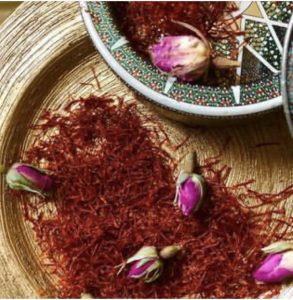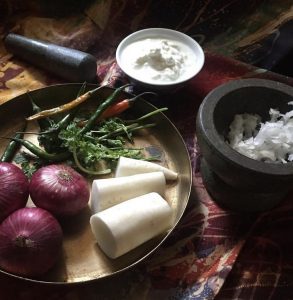Where there is spice, there are kitchen implements to grind them. And because Asia grows and uses quite a large  proportion of the world’s spices, most of the spice grinders have an Asian sensibility.
proportion of the world’s spices, most of the spice grinders have an Asian sensibility.
Depending on their job: pounding, dry and wet grinding all have different shapes of implements, they are variously made of limestone, granite, lava rock, betel wood, brass, bronze, apple wood or keekar, clay or porcelain. Their great advantage over the food processor is that the texture of the ingredients is not bludgeoned into nothingness. Also, flavours either remain or intensify, but never deteriorate.
The flat grinding stone with the hand-held stone tablet is one end of a continuum that metamorphoses into the mortar and pestle shaped like a well. In between there are a welter of designs that change slightly depending on which part of the world they are. The flat tablet is used to grind mainly dry  ingredients that need to be moistened with the addition of a few drops of water or a single ingredient that contains moisture like ginger and/or garlic. Thus, in Bengal, every household the shil nora on which mustard seeds, whole turmeric root or poppy seeds are ground to a paste daily. Many Kolkata families have a succession of part-time maids, one of whom is co-opted into grinding spices for the day. I even have a bachelor friend, who keeps madly irregular hours, who insists on grinding his spices on a shil nora himself, even at the improbable hour of 3 am, rather than have a food processor to do the job. “All it takes is a few minutes,” he tells me, with a look of genuine surprise at my question. And quite right he is too. Another friend from Kolkata, talks with eyes agleam at the concept of ‘teasing out the flavours of the spices’ from a shil nora’. The first spice to be crushed on the flat tablet is whole haldi in its dry form. It is inconceivable to grind turmeric in any other part of the country but in Bengal, it is all in a day’s work. A few drops of water and a couple of well-aimed knocks, and the bulb or ‘finger’ as it’s called in the trade, is broken into more manageable pieces.
ingredients that need to be moistened with the addition of a few drops of water or a single ingredient that contains moisture like ginger and/or garlic. Thus, in Bengal, every household the shil nora on which mustard seeds, whole turmeric root or poppy seeds are ground to a paste daily. Many Kolkata families have a succession of part-time maids, one of whom is co-opted into grinding spices for the day. I even have a bachelor friend, who keeps madly irregular hours, who insists on grinding his spices on a shil nora himself, even at the improbable hour of 3 am, rather than have a food processor to do the job. “All it takes is a few minutes,” he tells me, with a look of genuine surprise at my question. And quite right he is too. Another friend from Kolkata, talks with eyes agleam at the concept of ‘teasing out the flavours of the spices’ from a shil nora’. The first spice to be crushed on the flat tablet is whole haldi in its dry form. It is inconceivable to grind turmeric in any other part of the country but in Bengal, it is all in a day’s work. A few drops of water and a couple of well-aimed knocks, and the bulb or ‘finger’ as it’s called in the trade, is broken into more manageable pieces.
 Families who hail from West Bengal – Ghotis as they’re known, use a great deal of poppy seeds in their cooking. As anyone who has tried to grind the little off-white devils in a coffee grinder knows, it’s a fiendishly difficult job. It is far easier to do it on a shil nora, with a few drops of water to make it cling to the grinding stone.
Families who hail from West Bengal – Ghotis as they’re known, use a great deal of poppy seeds in their cooking. As anyone who has tried to grind the little off-white devils in a coffee grinder knows, it’s a fiendishly difficult job. It is far easier to do it on a shil nora, with a few drops of water to make it cling to the grinding stone.
In Goa, life in the villages is more or less the same as in other traditional pockets of the country. Every kitchen has both models, called fathor and wahn. Fathor, the tablet is used for cumin, peppercorns and green chillies that are ground together for a variety of fish curries, with powdered haldi being added to the other spices on the stone. This was a throwback to the times when even haldi root was pounded on the flat stone. You do need strong shoulders and forearms to keep up a certain pressure on the flat stone with the round-sided triangular tablet in your hands as you work it back and forth over and over again, bringing stray blobs of semi-ground spices back into the centre of the flat stone, to be ground further.
In Goa, the mortar and pestle – so large and heavy that it was usually cemented into place in a corner of the kitchen –  was called wagh and was far easier to handle. You never actually had to lift the egg-shaped pestle up: that was a job more suited to heavy-weight champions, so heavy was it. All you did was slide red chillies, grated coconut and the other spices into the well of the pestle, sit on a 6 inch stool a few centimeters off the ground, and work the pestle round and round in a constant motion. After over half an hour, the coconut started to become almost silky smooth. You’d continue till you had the consistency you wanted. Aristocratic families – who were also land-owners – had so many coconut trees that they didn’t have to grind coconut. They’d just grate it and add it to hot water two times, extracting the milk and discarding the rest. Families of more modest means could not afford to waste the coconut, and so, were obliged to grind it. Well-shaped it may be, but it was used to grind rather than pound spices. Pounding spices has one effect; grinding them quite another. However, it is interesting to note that whether you pound a teaspoon of dry whole spices in a small metal bowl with its own club-shaped implement to render them into powder, or a gigantic prototype that is too heavy to be moved, even by an inch and which is used with an oval stone in a grinding, circular
was called wagh and was far easier to handle. You never actually had to lift the egg-shaped pestle up: that was a job more suited to heavy-weight champions, so heavy was it. All you did was slide red chillies, grated coconut and the other spices into the well of the pestle, sit on a 6 inch stool a few centimeters off the ground, and work the pestle round and round in a constant motion. After over half an hour, the coconut started to become almost silky smooth. You’d continue till you had the consistency you wanted. Aristocratic families – who were also land-owners – had so many coconut trees that they didn’t have to grind coconut. They’d just grate it and add it to hot water two times, extracting the milk and discarding the rest. Families of more modest means could not afford to waste the coconut, and so, were obliged to grind it. Well-shaped it may be, but it was used to grind rather than pound spices. Pounding spices has one effect; grinding them quite another. However, it is interesting to note that whether you pound a teaspoon of dry whole spices in a small metal bowl with its own club-shaped implement to render them into powder, or a gigantic prototype that is too heavy to be moved, even by an inch and which is used with an oval stone in a grinding, circular  motion, English has no other name for it except ‘mortar and pestle’. It is rather like the words ‘uncle’ and ‘aunt’ used to describe relationships that in Hindi are named far more precisely: chacha, tau, mama, maasu, chachi, tai, maami, maasi and so on.
motion, English has no other name for it except ‘mortar and pestle’. It is rather like the words ‘uncle’ and ‘aunt’ used to describe relationships that in Hindi are named far more precisely: chacha, tau, mama, maasu, chachi, tai, maami, maasi and so on.
More or less the same principle is used further down the west coast in Kerala, where home cooks use the rotary mortar and pestle for coconut-based mixes, as well as pootu, idli and dosa batters, while more or less dry spices with just one or two ‘wet’ ingredients like green chillies or ginger are ground on the stone tablet.
I’ve seen many versions on the theme of grinding stones. In Chettiyar homes, the flat stone has a smaller stone shaped exactly like a chapatti-making belan. Old retainers make exceedingly light work of grinding mainly dry spices with enough water to moisten it into a paste, which is the whole objective of grinding stones. Coimbatore is surrounded by granite mines where the special quality of the stone is that it  does not heat up easily, making it eminently suitable for grinding stones and idli grinders.
does not heat up easily, making it eminently suitable for grinding stones and idli grinders.
In Kashmir, the neum tchota is a piece of limestone that is shaped like a well. The instrument is used to pound, as opposed to grind spices. The pestle is a stout wooden stick made of apple wood or cedar. It is used to make chutneys and to pound lamb mince finely; spices get pulverized almost incidentally, but if you just want to pound whole spices for a single dish, you would use a miniature mortar pestle, also made out of limestone. On the other hand, if you are pounding the annual supply of whole chillies into powder, you would use a kanz-mohool, so large a pounding instrument that it is left year-round in the courtyard and never brought indoors. The kanz too is made of limestone.
 Panthachowk, outside Srinagar, has a quarry for Kashmir’s mortars of all sizes. In Solan, Himachal Pradesh, I spied a row of shops selling limestone mortars and pestles of identical design. And in the Goa-Maharashtra belt, certain roads have permanent markets selling household accessories, of which stone mortars and pestles are an integral part, often being chipped into shape on the road itself.
Panthachowk, outside Srinagar, has a quarry for Kashmir’s mortars of all sizes. In Solan, Himachal Pradesh, I spied a row of shops selling limestone mortars and pestles of identical design. And in the Goa-Maharashtra belt, certain roads have permanent markets selling household accessories, of which stone mortars and pestles are an integral part, often being chipped into shape on the road itself.
In Lucknow, a metal hamam dasta does the job of pounding dry spices, but every roadside “household items” cart all over the country has a few sizes of marble, marble-dust or ceramic miniatures that look too toy-like to actually be of much use. I have seen a larger, more robust version of it in a Pune household, made of iron. Though the bowl was no more than a foot high, it was impossible to lift it off the ground. At best, you could drag it a few feet. Its main use was for grinding spices for Goda masala, best made at home once a year.
India is not alone in having a small, portable device for hammering spices till they break into pieces. Thailand has such a contrivance made variously of betel wood and baked clay. In a delightfully atmospheric store in rue Montorgueil near  Les Halles, in Paris, every last Moroccan spice was on display in sacks that lined the long shop down its entire length. I could scarcely believe I was in Europe, assailed as I was by the fragrance of ras al hanout and every other spice used in North African cooking. The man who ran it (he did not speak a word of English) asked his grandson to grind a spice in the hamam dasta. The chirpy little boy did it with a surprisingly good grace. I was even more surprised by the rhythm that he pounded. It was almost as if he was keeping time to a folk ditty while pounding the spice. There was no sign language to express what I wanted to ask, but I did get the impression that the little boy’s mother – if not the community at large – pounded spices in time to a tune. He was too small to have worked out a fun way of making his task lighter by himself.
Les Halles, in Paris, every last Moroccan spice was on display in sacks that lined the long shop down its entire length. I could scarcely believe I was in Europe, assailed as I was by the fragrance of ras al hanout and every other spice used in North African cooking. The man who ran it (he did not speak a word of English) asked his grandson to grind a spice in the hamam dasta. The chirpy little boy did it with a surprisingly good grace. I was even more surprised by the rhythm that he pounded. It was almost as if he was keeping time to a folk ditty while pounding the spice. There was no sign language to express what I wanted to ask, but I did get the impression that the little boy’s mother – if not the community at large – pounded spices in time to a tune. He was too small to have worked out a fun way of making his task lighter by himself.
I myself have a host of tiny grinding stones, made variously of limestone, betel nut wood, olive tree wood, Jaisalmer stone and brass. They each have different depths and widths: the deepest does not allow cumin seeds to come flying back out, the widest is useful for pounding crisply fried onions and the one that I use most often is the limestone one, because of the way the spices become more fragrant once they’ve  been in contact with it.
been in contact with it.
In Indonesia, grinders usually have to do the job of bruising spices, herbs and candlenuts together, so the mortar is shaped with a twist at the end, the better to do the job. Thai mortar and pestles for spice (as opposed to those for bruising salad ingredients like raw papaya and dried shrimp) too are made in sizes and materials that look good on restaurant tables, to give guests the experience of “preparing” their own ingredients.
Istanbul has a spice market that is something of a travesty: more silk cushion covers, nougat and a few modest piles of cumin and coriander are all sold under the package of exotica. Exotica it certainly is – vaulted ceilings gave it a souk-like feel and if most of the merchandise on offer came from a factory, there were also spice grinders: pepper mills that had a handle that turned. I promptly bought a couple for my collection, but it was only after I returned home that I realized that they were meant for spices that you grind onto your plate. It had rather limited applicability for me, but I can imagine that za’atar or baharat would have a certain cachet by being ground in one of these little implements.
 Outside of Asia, spice pounding implements are used, although they are not as common as they are in Asia. One implement that you’ll never find in traditional Indian kitchens is the nutmeg grater of the western world. Even those kitchens throughout India that use nutmeg would be likely to have an alternative arrangement for pounding nutmeg. Nutmeg graters are tiny and look quite unlike the mostly large, heavy duty, no-nonsense implements used to pound or grind spices in India.
Outside of Asia, spice pounding implements are used, although they are not as common as they are in Asia. One implement that you’ll never find in traditional Indian kitchens is the nutmeg grater of the western world. Even those kitchens throughout India that use nutmeg would be likely to have an alternative arrangement for pounding nutmeg. Nutmeg graters are tiny and look quite unlike the mostly large, heavy duty, no-nonsense implements used to pound or grind spices in India.
Other than that, Mexico has two instruments, one for grinding and another for pounding. The metate is an almost flat tablet that is primarily used for spices and is confined to the kitchen. The molcajete is a wide-mouthed stone bowl with a pestle to bruise avocados and tomatoes for salsas. Of course, it is not only spices that are ground in a metate but sometimes cacao beans too! In fact, the logo of the French chocolaterie La Maison du Chocolat is a stylized metate!
In Kotka in South Finland, I visited a country inn, Karkisaari, for lunch and was blown away to find an entire mantelpiece covered with brass spice grinders in various shapes. The management looked on, completely nonplussed,  as I went gaga over my new finds. They simply couldn’t imagine what all the fuss was about. To me, just discovering that someone on the other end of the globe had more spice grinders than I had was a revelation. Not only that, the fact that they were made in brass and looked suspiciously similar to the ones found all over India made the whole incident surreal. So when I spied a (completely useless) wooden spice grinder in Pentik, a design store in Helsinki, I snapped it up. Just to add to my collection.
as I went gaga over my new finds. They simply couldn’t imagine what all the fuss was about. To me, just discovering that someone on the other end of the globe had more spice grinders than I had was a revelation. Not only that, the fact that they were made in brass and looked suspiciously similar to the ones found all over India made the whole incident surreal. So when I spied a (completely useless) wooden spice grinder in Pentik, a design store in Helsinki, I snapped it up. Just to add to my collection.
However, the most ingenious mortar and pestle I’ve seen was in Terence Conran’s Habitat, amidst mouth-watering kitchen and table accessories. It was from Peru – not a country I would associate with spice use. It was so elegant that at first I mistook it for a table decoration: a circular plate, with just the tiniest raised edge and the largest tennis-ball sized granite mortar. Every surface was satiny smooth to the touch and the only reason I didn’t grab it was because it would have added a hideous amount of weight to my already groaning luggage.
It made me realize how large, yet how tiny, the world of spice really is.








